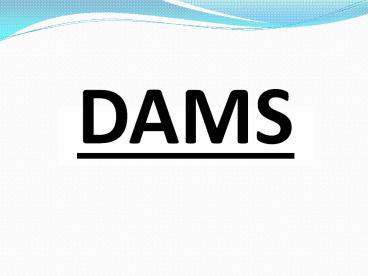DAM TYPES - PowerPoint PPT Presentation
Title: DAM TYPES
1
DAMS
2
Definition-
-
Dam is a solid barrier constructed at a
suitable location across a river valley to
store flowing water - Storage of water is utilized for following
objectives - - Hydro power
- Irrigation
- Water for domestic consumptn
- flood control
- For navigational facilities
- Other additional utilization is to develop
fisheries
3
(No Transcript)
4
Purpose Distribution of Dams
5
TYPES OF DAMS
- Based on Structural Design-
- 1. Gravity dams
- 2. Arch dams
- 3. Buttress dams
6
Gravity dams-
- A gravity dam is a
solid structure, made of concrete or masonry,
constructed across a river to create a reservoir
on its upstream. - Where good foundations
are available, gravity dams
can be built up to any
height. - It is the most permanent one,
and requires little maintenance.
7
GRAVITY DAM
8
Arch dams-
- These type of dams
are concrete or masonry dams which are curved or
convex upstream in plan - To save in the volume of
concrete. - Good for U-shaped valleys
- Easy construction
Reservoir Force
Dam weight
9
ARCH DAM
10
Buttress dams-
- these type of
dames water-tight upstream side that is supported
at intervals on the downstream side by a series
of buttresses or supports. - Buttress dams require less
concrete than gravity
dams. - can be constructed on
relatively weaker
foundations.
Reservoir Force
Dam weight
supports
11
BUTTRESS DAM
12
ADVANTAGES-
- Once a dam is constructed, electricity can be
produced at a constant rate. - The lake's water can be used for irrigation
purposes. - The build up of water in the lake means that
energy can be stored until needed, when the water
is released to produce electricity. - When in use, electricity produced by dam systems
do not produce green house gases. They do not
pollute the atmosphere.
13
DISADVANATGES-
- Dams are extremely expensive to build and must be
built to a very high standard. - The flooding of large areas of land means that
the natural environment is destroyed. - People living in villages and towns that are in
the valley to be flooded, must move out. This
means that they lose their farms and businesses.
14
(No Transcript)































